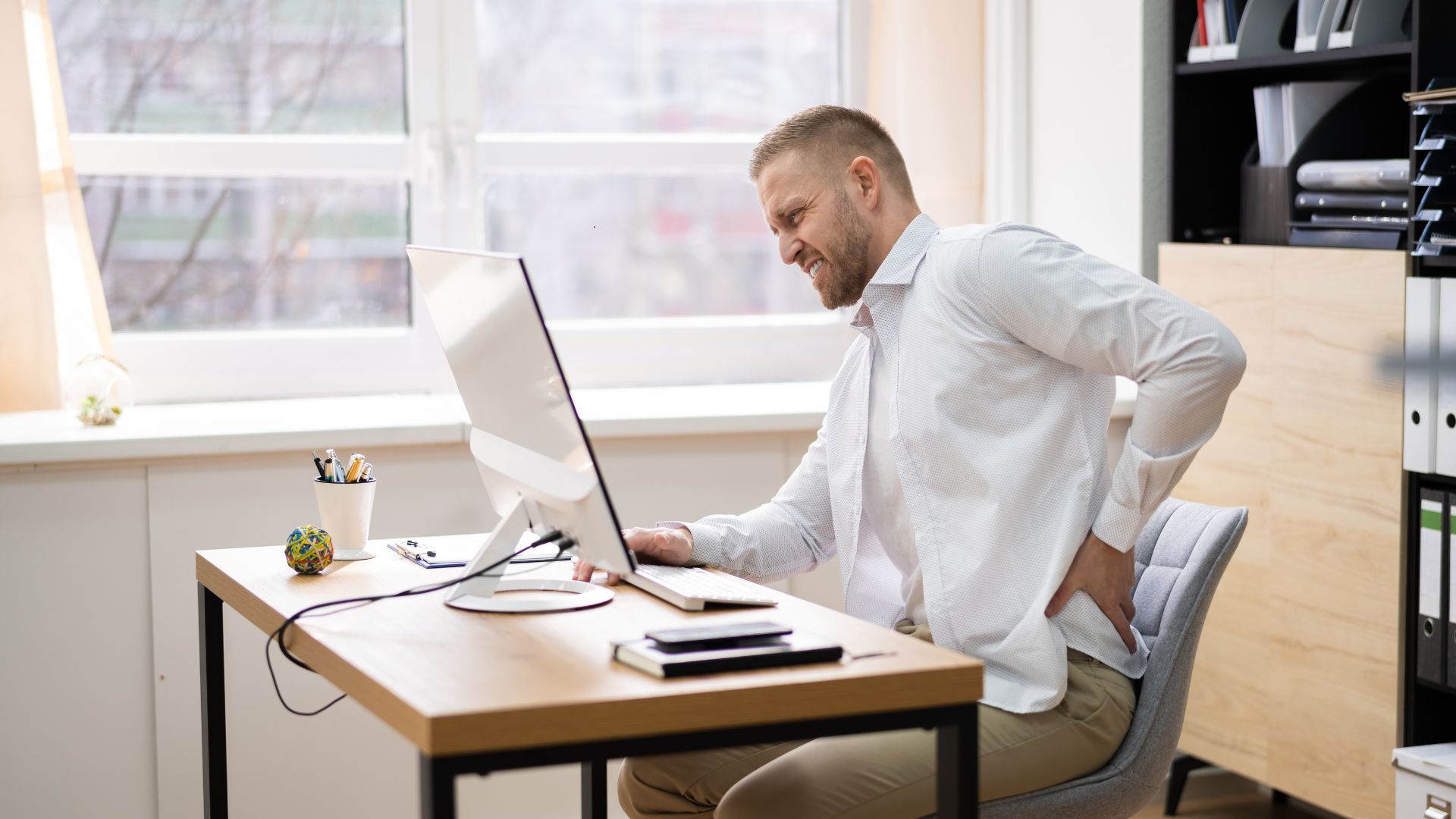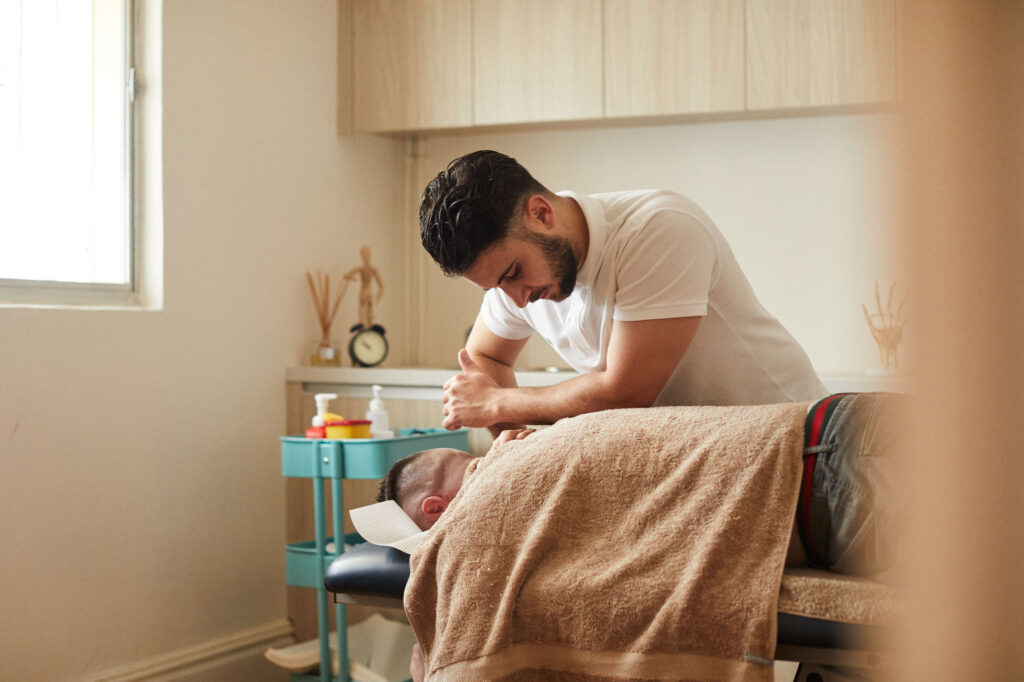10 Easy Home Office Stretches to Relieve Pain and Boost Productivity

Feeling stiff after hours at your desk? Incorporating simple exercises can help alleviate discomfort. You’re not alone. With the rise of remote work and hybrid office arrangements, more office workers in their desk job are experiencing neck pain, tight hips, and poor posture—all thanks to prolonged sitting and suboptimal home office setups during extended periods.
But here’s the good news: a few simple desk exercises, along with stretches, and regular breaks can make a world of difference to office workers.
Why Stretching Matters in a Home Office
The Perils of Prolonged Sitting
Sitting for long periods causes more than just a numb bum. It leads to:
- Tight hip flexors
- Decreased spinal mobility
- Reduced joint lubrication
- Increased pressure on your neck and shoulders
- Poor blood flow and energy levels

The Neck Carries the Load
Did you know your head accounts for roughly 9% of your total body weight? And it’s supported by the thinnest part of your spine—your neck. This remarkable design allows your head to move freely, but it also means the hundreds of muscles in your face, neck, and shoulders are under constant strain, contributing to potential musculoskeletal disorders .
Sitting still while staring at screens decreases the release of joint-lubricating fluids, making your neck stiff and sore. Add awkward angles from a makeshift desk setup, which may also affect your right knee and your muscles are forced to overcompensate, potentially leading to shoulder pain . Hello, bend forward, headaches and “tech neck”!
Regular Movement Is the Secret
The fix isn’t finding the “perfect” posture—it’s moving more, more often, especially avoiding keeping your shoulders forward. Micro-breaks and desk mobility exercises, while keeping your hips square, keep your joints happy and muscles relaxed. A 5-minute desk stretch sequence as part of your daily routine can do wonders for your comfort and concentration.
Ergonomic Tips Before You Stretch
Make your workspace work with you, not against you.
- Chair: Feet flat on the floor, thighs parallel to the ground
- Desk height: Elbows at a 90-degree angle
- Monitor height: Top of the screen at eye level to avoid a forward-leaning head
- Support: Use a footrest or folded towel if needed
- Lighting: Minimise screen glare to reduce eye strain
10 Home Office Stretches You Can Do at Your Desk
Each stretch below is easy, effective, and designed to target the most common tension zones for desk workers in a seated position . Aim to hold each for 5 seconds, repeating 5 times, unless otherwise noted.
1. Neck Rolls & Chin Tucks
Targets: Neck stiffness, posture alignment
How to:
- Slowly roll your head from one shoulder to the other, pausing at each side.
- Then sit tall and tuck your chin straight back (not down) as if you’re giving yourself a double chin. Hold, then release.
Why it helps:
Improves neck flexibility and activates the deep muscles under your skull, helping pull your head back into alignment.
2. Shoulder Shrugs
Targets: Trapezius tension
How to:
- Inhale and raise your shoulders toward your ears.
- Exhale and drop them quickly. Repeat.
Why it helps:
Releases built-up tension from holding your shoulders up while typing or concentrating, especially during shoulder extension.
3. Levator Scapula Stretch
Targets: Side of the neck and upper shoulders
How to:
Incorporate easy stretches to relieve tension.
- Sit on your right hand.
- Tilt your head forward and to the left, using your left hand to deepen the stretch.
- Repeat on the other side.
Why it helps:
Can help reset overworked muscles that stabilise your shoulder blades—especially after long hours of slouching.
4. Seated Spinal Twist
Targets: Mid-back, posture muscles
How to:
- Sit tall, cross one arm over to the opposite knee, and gently twist from the waist.
- Keep your hips steady and spine upright.
Why it helps:
Unlocks thoracic (mid-back) mobility and improves circulation to your spine.
5. Shoulder Blade Squeeze
Targets: Rhomboids, upper back
How to:
- Sit tall with chin tucked.
- Squeeze your shoulder blades together as if holding a pencil between them.
- Hold for 3–5 seconds, then relax.
Why it helps:
Encourages a more upright spine and reduces strain on the neck and upper back from rounded shoulders.
6. Wrist and Finger Stretch

Targets: Forearms, wrists, and fingers
How to:
- Extend one arm forward, palm up.
- Use your other hand to gently pull the fingers down.
- Flip the palm down and repeat in the opposite direction.
Why it helps:
Counteracts typing strain and reduces the risk of carpal tunnel syndrome by ensuring your palm’s facing is correct.
7. Scalenes Stretch
Targets: Side neck muscles
How to:
- Sit tall, turn your head to one side.
- Slightly tilt your head back and apply gentle pressure with your fingertips.
- Avoid pushing your head forward.
Why it helps:
Relieves tension in small but vital muscles that maintain neck alignment.
8. Hamstring Stretch (Standing)
Targets: Back of the thighs and left leg
How to:
- Stand up, place one heel on a chair or step.
- Keep your leg straight and hinge forward from the hips.
Why it helps:
Tight hamstrings pull on the lower back—stretching them improves lower back and hip comfort.
9. Calf Raises
Targets: Circulation, ankle flexibility
How to:
- Stand up and slowly raise your heels off the floor.
- Hold briefly, then lower.
Why it helps:
Stimulates blood flow and prevents stiffness from sedentary legs.
10. Seated Forward Fold
Targets: Spine, lower back, and right leg
How to:
- Sit on the edge of your chair.
- Let your arms and head fall forward between your knees.
- Breathe deeply for 5–10 seconds.
Why it helps:
Gently decompresses the spine and stretches the lower back muscles.
Bonus: Eye Exercise for Digital Fatigue
Targets: Eye strain
How to:
- Every 20 minutes, look at something 20 feet away for 20 seconds.
(This is called the 20-20-20 rule.)
Why it helps:
Gives your eye muscles a break and helps prevent computer vision syndrome.
When and How Often Should You Stretch?
Consistency is key. You don’t need to do all 10 stretches at once—just a few at regular intervals makes a big impact.

Suggested routine:
- Set a reminder to stretch every hour, or at least 3–4 times daily.
- Use calendar pop-ups or smartphone alarms.
- Pair a stretch break with water refills or snack times.
Quick 5-Minute Stretch Routine
Short on time? Try this simple combo to hit the main tension points:
- Shoulder Blade Squeeze – 5 reps
- Chin Tucks – 5 reps
- Levator Scapula Stretch – 5 reps each side
- Seated Spinal Twist – 5 reps each side
- Wrist Stretch – 5 seconds each direction
Repeat twice a day for a quick reset!
Stretching Not Providing Enough Relief?
If you’re still feeling stiff, sore, or uncomfortable even after stretching, it might be time to go beyond at-home remedies, especially if you experience discomfort in your left knee. Stretching is a great way to maintain flexibility and promote healthy movement patterns, but it’s not always enough—especially if you’re dealing with persistent pain from too much sitting, limited mobility, or underlying musculoskeletal imbalances.
At Incline Health, our experienced team of physiotherapists and chiropractors work closely with you to create tailored, results-driven programs designed to address the root cause of your discomfort throughout the day —not just the symptoms.
Why You Might Need More Than Just Stretching
Working from home often means prolonged sitting, suboptimal ergonomics, and repetitive strain on your body. Over time, this can lead to various issues, including musculoskeletal pain :
- Chronic neck and lower back pain
- Recurring headaches
- Postural misalignment
- Reduced range of motion
- Tingling or numbness in the arms or legs
- Tightness that doesn’t release with regular stretching
If you’re noticing any of these issues, our team can help you take the next step toward lasting relief and better movement.
How Physiotherapy Can Help

Our physiotherapists begin by conducting a comprehensive assessment of your symptoms, posture, daily habits, and workstation setup. We identify any muscular imbalances, joint restrictions, or movement patterns that may be contributing to your pain or stiffness.
From there, we’ll develop a personalised rehabilitation plan.
We don’t just treat the pain—we equip you with the tools to move and feel better long term.
How Chiropractic Care Complements Your Program
Chiropractic treatment at Incline Health is focused on optimising your spinal alignment and joint health, which can be complemented by shoulder rolls. When your spine isn’t properly aligned, your muscles and nervous system must work harder to compensate, which can lead to chronic tension, reduced mobility, and increased pain.
Our chiropractors use safe, gentle techniques to:
- Realign the spine and joints
- Reduce nerve irritation
- Enhance mobility and flexibility
- Improve postural awareness
- Support the natural function of your nervous system
This hands-on approach is ideal for clients who feel like they’re constantly “tight” despite stretching or who experience pain that radiates down the arms, shoulders, or legs.
At Incline Health, we believe that every body is different. That’s why we integrate physiotherapy and stretching exercises, including techniques to help you keep your chest outward, with chiropractic care to build a well-rounded, tailored treatment plan that suits your individual needs, goals, and lifestyle.
Whether you’re a desk worker experiencing work-from-home fatigue, a parent juggling movement demands, or someone simply seeking relief, we’re here to guide you every step of the way.
Book a consultation today and let us help you move better, feel stronger, and live pain-free.
Book a Physio or Chiropractic Appointment Today
Take care of your body—it’s the only desk you’ve got!
By integrating these ergonomic stretches into your home office routine, you’ll feel more energised, focused, and ready to tackle your workday.






